
Has Twitter screwed up with the blue ticks?
Recently a number of higher profile people have voiced concerns about the blue checkmark / tick that Twitter made irrelevant by allowing anyone to get one.
Shaan Puri called it "dumb". Nikita Bier and Marc Cuban said their notifications are unusable because of it.
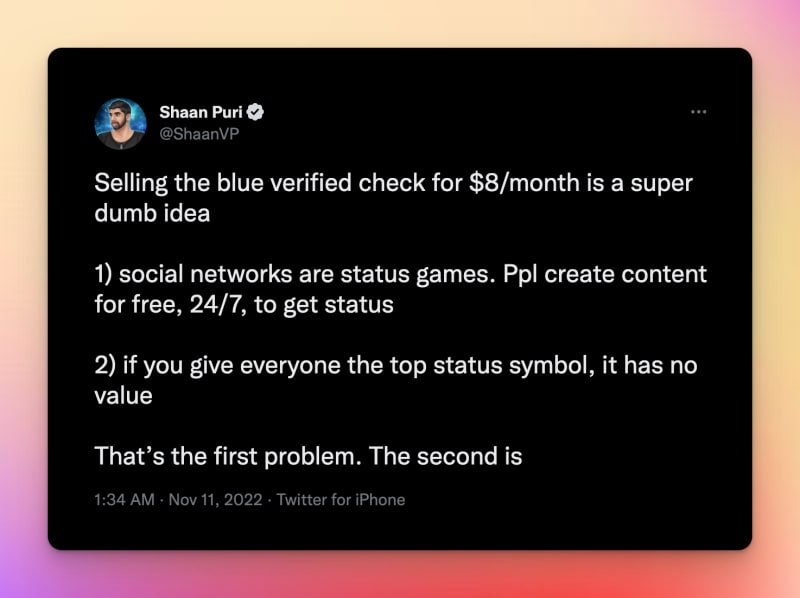
Are they right? Did Twitter make a bad move?
Let's dig a bit further to understand what is really going on psychologically and whether Twitter made a giant mistake.
Enter MMOs
One of the easiest ways to understand social / gamified incentives is to look at MMOs (massive multiplayer online games).
In an online game with many other players, the primary function that drives progression and incentivizes continued play is character attributes. Characters progress by leveling up and gaining attributes that make their characters stronger.
For most players, the act of progression is most of the fun. Sure, the cool boss monster fights and other events are awesome too, but the main driver of satisfaction, ironic as it may be, is the grind.
Like social networks, games seek to maximize your play time (in the hopes that you spend more). Designers introduce content throughout the level progression which utilizes higher and higher attributes. With stronger monsters you get better loot. With better loot you kill stronger monsters. With better loot you can buy other things which eventually amount to some form of status (wealth in the game), but this too has a natural cap.
Like MMOs, Twitter has stats and progression. The follower count, or better yet, follower ratio combined with high follower count is the attribute of progression on Twitter. The vast majority of accounts on Twitter, as in games, are in the act of progressing and have not reached the end game content. Even when they do, other status symbols remain (such as the verified blue tick).
When people claim that blue checks ruined progression incentives, this is only half true - an experience reflected in the person making the claim (usually themselves a blue tick).
In reality, there is not one status system, but at least two:
- Follower count - your MMO equivalent of levels and attributes
- Blue tick - status symbol
For most people, the blue tick is unattainable and is not the end goal of participation. The average person does not have hundreds of thousands of followers, in fact , they may have fewer than 1,000.
Newbies
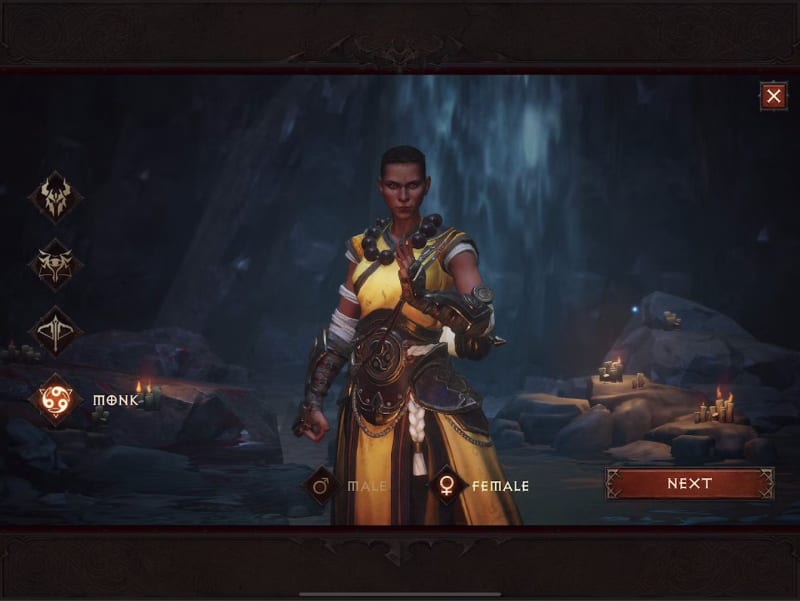
Newbies start with newbie gear and low stats - enough to kill critters.
Like MMOs, we have newbies who are there just to explore the platform without investing any serious time. They browse and like things but have little to nothing to say. These are the people who have less than 100 followers, MMO equivalent of total newbies with starter gear, bashing on spiders and bunnies in your nearby forest. The last thing they think about is acquiring that coveted blue tick.
Explorers
Then we have the invested players (Explorers) - the ones who decided "I like this game, I'll give it more effort to see where things go".
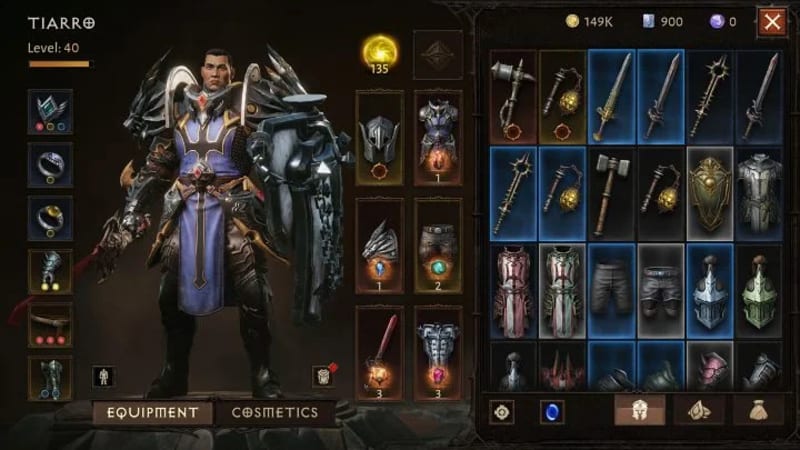
Explorers have sunk more time into a game. They start acquiring a few pieces of rare gear and see the benefit of continuing investing time into the game.
Explorers are incentivized to level up - they are already hooked on early stage content and they want to see what else is out there. They quest and grind to level up their stats and gear.
On Twitter, these are the people with around 1000 followers, plus or minus. They've left the total newb territory, the beginner spawn zone so to speak and are now adventuring into journeyman-level dungeons. They even team up with others to form groups and raids to defeat stronger monsters and take on bigger challenges.
The serious gamers
Then we have the serious gamers. People who are more than dedicated to progress in the game. They realize that the status of the strongest player is attainable - you just have to put in the work. A lot of work.
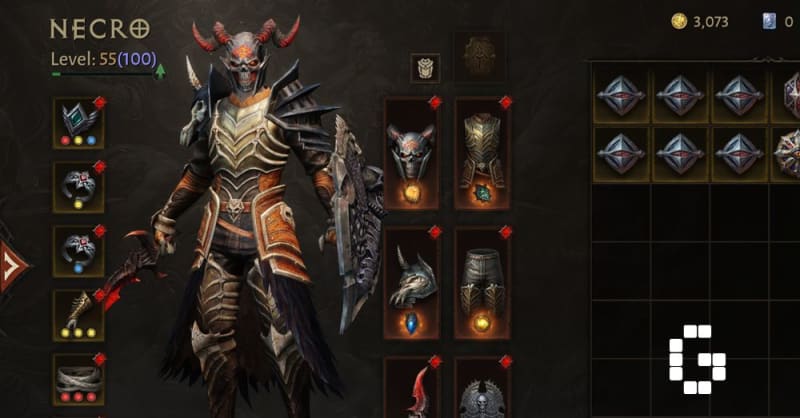
Serious gamers achieve much higher levels and start accumulating serious loot, but lack considerable status.
On Twitter, I would equate them to people with 1,000-10,000 followers.
Like all before them, their incentives are still the progression of stats and gear.
A serious gamer may see the end game as an alluring goal and they will do all they can to become a very strong player to be able to try the end game content.
Hardcore gamers
Eventually, every MMO introduces hard game content that is meant only for the hardcore gamer. This is a player who has already reached the top stats and has played all of the typical maps and dungeons - but few large challenges remain. Raids, end-game epic battles, castle seiges - all the super fun stuff that only the hardcore gamer will enjoy most if they attain the top gear.
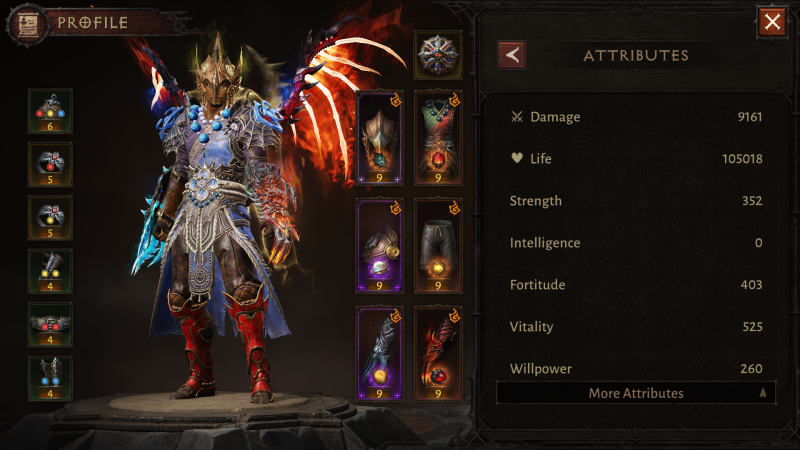
Hardcore players spend considerable time and or money to acquire the top gear and attributes. They are looked at with admiration, but are not quite at the highest status.
On Twitter, these are people in the 10,000-100,000 follower range. Their goal is still primarily attribute gain. They may even start seeking status past the 20k follower mark, but they are still mostly thinking about the ultimate stats that make other players oggle in their presence.
Yet, having end-game hardcore gear and stats beyond your typical level-capped player is not the ultimate status symbol. This is where challenges and titles come in.
Title Bearers
In MMOs, several paths to titles exist. For some, a title is attainable by starting a guild and becoming a guild master. For others, a PVP title is prized above all else. Players join player-vs-player battles to unlock new ranks and status.
This is the point where hardcore gamers become server figures - people that are recognized server-wide just by having achieved that highest point of the game.
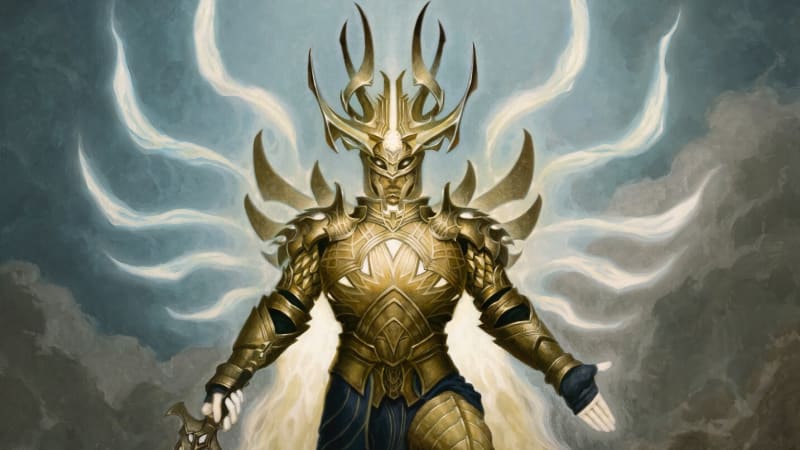
Players who hold certain titles are widely recognized across servers, and even become part of the game's lore.
On Twitter, these highest-achievement players are the blue ticks (prior to Twitter giving them out to everyone). It is not enough to be one of the top players, you have to be important enough and worked hard enough to acquire your title. I guess you could say that skill is now a factor in your standing.
Of course, there are exceptions and people get blue checks for dumb reasons - equivalent of achieving a top PVP rank in your class when nobody is online. But for the most part, blue checks / top titles are distinguished accomplishments. When they speak, people listen.
Back to our concerned
"social networks are a status game" - Shaan Puri
I argue that social networks are a combination of both - progression game as outlined in my MMO comparison, followed by status symbols. The status part doesn't kick in until you get to a certain point of your journey.
"people create content 24/7 to get status"
I argue that people create content 24/7 to progress their online persona. Status does not enter the picture until much later. Even then, it is questionable whether high follower accounts create content for the sake of status. Many people in that position are usually seeking to monetize their audience. Others may be there just to stay relevant in society - to feel validated that what they say still matters.
It's easy to understand why Shaan may feel this way - after all he is a notable person on Twitter with over 300,000 followers. For him and others like him, a check mark IS the status symbol. For Shaan, having 300k followers or 800k hardly makes any difference. The 1 million follower mark may be a symbolic point, but after that it's all pointless. The only thing that matters is that highly coveted status symbol. Shaan, like many others, may also use his standing to monetize his audience - directly or indirectly.
For the vast majority of people who do not fit Shaan's profile, the status symbol is not important. For those people, progression of their character is what really matters. From 0 to 1000, then to 10,000 followers and beyond is the actual journey most people are so eager to take on. It is only when these people join the hardcore gamer group that they will start thinking about bearing titles.
Is Shaan correct about the motivation behind content creation?
Only partially.
People will create content to increase their follower numbers, but at some point the follower count becomes meaningless. This is where there needs to be an incentive for our "Twitter whales" to participate. It's difficult for me to say what those incentives should be as I am not a Twitter whale myself. I imagine for some it may mean acquiring the blue tick. For others it may not matter much at all.
I also do not have data on how many content creators are blue ticks and how many aren't. If I had to guess, the vast majority of "content creators" - the ones who actually drive the bulk of the platform's engagement are NOT blue ticks. Even though it may seem otherwise as most big tweets involve blue ticks, I think this is a "what's focal is important" fallacy. In other words, these tweets are the most visible from one to another, but do not comprise the bulk of the platform interactions (which are driven by content creators without ticks).
Verification vs Status
It would be unfair to go any further without examining the previous functions of the blue tick. What Twitter got wrong from the very start is to combine status with verification.
We've already explored the role of the blue tick in status. People feel special knowing only few others share the same status.
Verification is where things broke down with the tick. By tying the tick with verification, Twitter shot itself in the foot when it comes to preventing spam on the platform. This is why we are in this situation today.
Verification and status cannot be the same thing.
Untangling the mess
How does Twitter untangle all of this mess?
Separate status from verification
People should be able to verify their identity or good will without acquiring status. This means that check marks should play no role in having a paid account. Whatever the future benefits of a paid account might be, they should have nothing to do with a blue tick.
One way to solve this would be to default all paid users to the previously "typical" account display - image, name, handle - that's it. No "verified", no badge, no tick.
This levels the playing field for everyone while reducing spam. Unpaid accounts would be treated a bit differently.
Creating designated labels for new accounts and those who change their names or handles
Most other social networks have long figured out that new users can be trouble and should be labeled as new. Reddit does this with explicit labels and Hacker News uses color to indicate new accounts. Twitter could explore with both.
However, this alone will not stop scammers as they will simply age an account, grow fake followers. This is where a label for name or handle change can make a difference (combined with color).
Change username or handle? > get a label next to your name and or turn your handle into a different color.
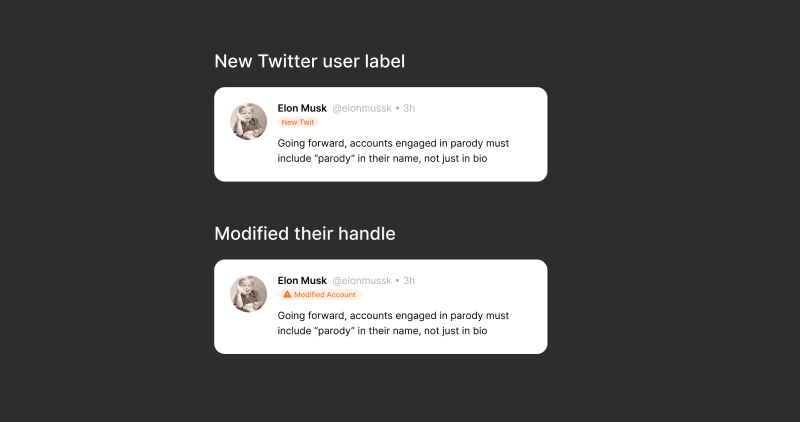
New users are given a label "New Twit". This helps combat blatant spam.
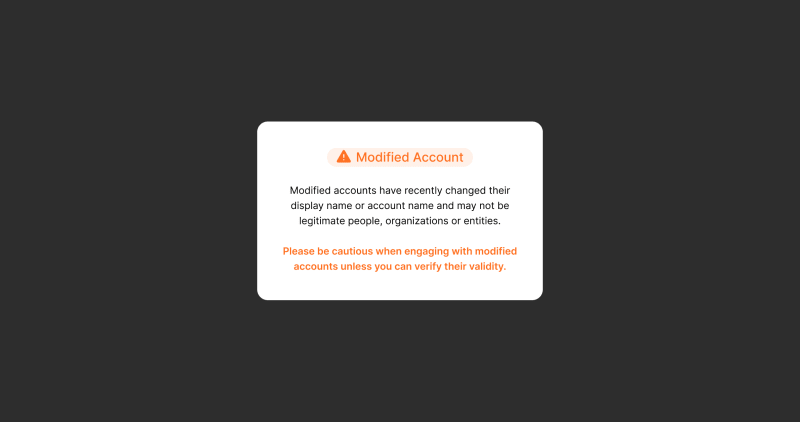
A warning is shown on hover (previously on click, but most people don't even know this exists...)
This will put a stop to people who change their names and handles to impersonate others. Simply by making a change to either of those things automatically puts a spotlight on your profile. Combined with the newbie label, there's very little if any chance to abuse any further.
Want to change back?
Pay additional verification fees to have your account reviewed. Attempt at impersonation results in a loss of deposit.
Another way to handle it would be to prevent name changes or handle changes and only apply a newbie label to new accounts.
Yet another way would be to charge for name and handle changes. Make it a significant amount, something like $100 and have the process pend a review where an actual human checks to make sure you are not trying to pull a scam. This would bring additional revenue to Twitter.
Incentivize content creation by rewarding progression
Nikita Bier had a good idea for this where a paying verified person would be able to showcase their recently gained follower count in their profile.
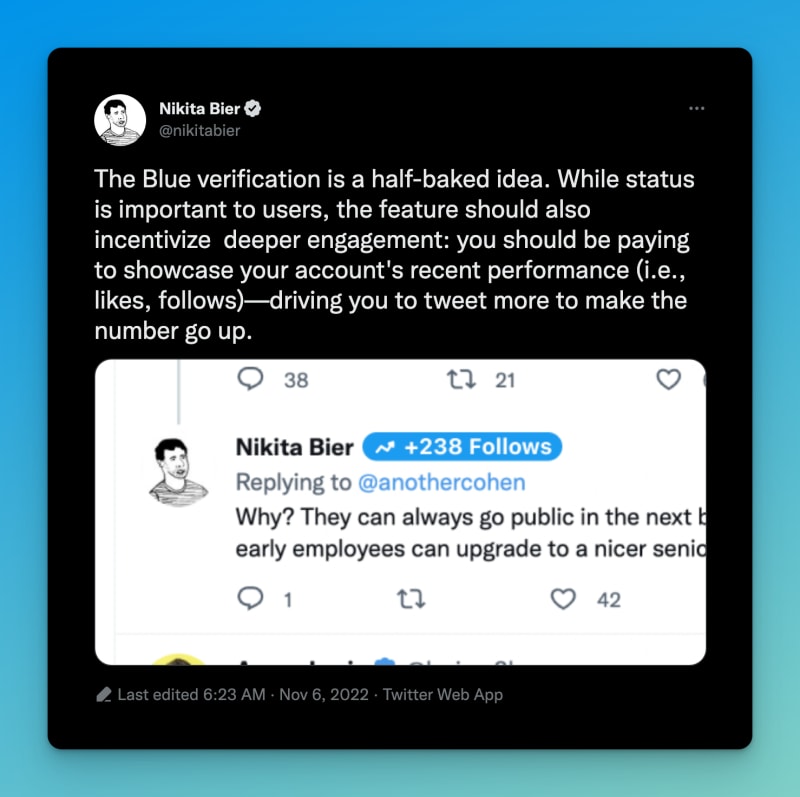
This does a great job of showing progression and semi-status, while incentivizing people to upgrade to a paid plan. When people see that someone is gaining followers, this is a signal that they may want to listen to that person, or at the very least learn more about them. Of course, this could be abused, and may not be an accurate representation of that person's content worthiness, but it's still an improvement.
But, what about status for people who have reached the end of progression incentives?
This is where creator tools would play a bigger role. The ability to monetize your audience might be a big enough incentive to not care about status symbols like ticks.
Things like audience capture, ecommerce, creator economy, paid music streaming, video monetization might all play a larger role in incentivizing sticking to the platform beyond millions of followers.
Those looking for status beyond financial gain could do something to their profiles (once clicked on). Exactly what that would look like I am still unsure... but I'm willing to be we could thing of some creative ways to reward people of societal status without letting their profile feed scream in the feed.
Evolving thoughts
To be clear, my thoughts on all of this are still evolving. I don't claim to have the right answer to everything - only that we should think about things a bit deeper beyond the surface level discussions occurring on Twitter.
Try to understand what motivates people on the platform no matter their level of achievement or progression. Also, don't reinvent the wheel and look at other social networks to see what is already working.